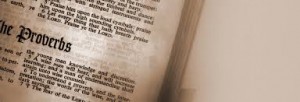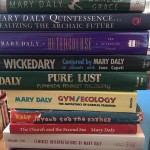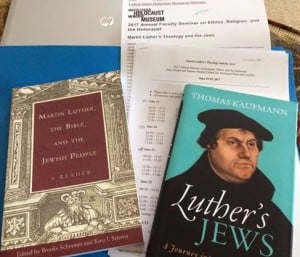 Some people have written about how Tim Burton’s film, Big Eyes, portrays the feminist journey of Margaret Keane, played by Amy Adams. Yet no one is talking much about the role of religion in her tale of eventual empowerment.
Some people have written about how Tim Burton’s film, Big Eyes, portrays the feminist journey of Margaret Keane, played by Amy Adams. Yet no one is talking much about the role of religion in her tale of eventual empowerment.
I certainly think there are feminist critiques of patriarchy embedded in the film. From the voiceover narration of Margaret fleeing her first marriage with nothing more than her paintings and her daughter in the late 1950s (before it became “fashionable” for women to do such things), to believing her husband Walter who insists that “people don’t buy lady art.” I was ready and waiting for the feminist trappings of the story.
I didn’t expect to see Margaret Keane as a seeker, winding her way through religions and other traditions of meaning-making. This is a far more complicated and interesting story in some way. While many articles written about her mention her eventual conversation to Jehovah’s Witness, Burton’s film suggests that Margaret was a seeker long before that. It does this in three key moments.
First, Margaret wanders into a confessional after lying to her daughter for the first time about who painted the waifs with the distorted eyes. She comments that she was raised Methodist and doesn’t really know what she is doing, but tells the priest that she’s upset about having told her daughter a lie at her husband’s prompting. The priest tells her that her husband probably has a good reason, and that it is her duty to trust his decisions. Sometimes a lie is for a greater good, he assures her. As Andi Zeisler puts it, in this moment “she finds that even God doesn’t seem to be on her side. ‘Your husband is trying to make the best of an imperfect situation,’ says the priest condescendingly.” This is a plausible idea at the time, and Margaret goes along with it. She isn’t satisfied, however.
The second moment in the film that shows the seeking-Margaret is when she sees the extent of the merchandising of her portraits, on posters and mugs and cards in the grocery store. She wanders, dumbstruck, down the store aisle and picks up a book on numerology. Not long after, she stands in the corner of the Keane Gallery near the paintings that she has convinced her husband Walter to let her claim for her own. She ends up in a lengthy and confusing explanation of the numerological significance of her initials, MBH, which appear above “Keane” in the artist’s signature corner.
 Still not satisfied with and reconciled to her life, Margaret eventually gets up the strength to leave Walter and move with her daughter to Hawaii. She keeps up the lies about the eyes for a while, however, as we learn when her exasperated daughter comments about not being allowed to have friends in to their house. The third, and defining, moment of faith-seeking comes when two Jehovah’s Witnesses come to her door to talk about their faith. Margaret invites the women in, and is subsequently shown reading from the bible about how corrosive lying is. (I didn’t write down the precise verse from the movie, but biblical texts that speak against lying are many, beginning with one of the ten commandments all the way through the book of Revelation, including several in Proverbs like 19:5, “a false witness will not go unpunished, and he who breathes out lies will not escape.”
Still not satisfied with and reconciled to her life, Margaret eventually gets up the strength to leave Walter and move with her daughter to Hawaii. She keeps up the lies about the eyes for a while, however, as we learn when her exasperated daughter comments about not being allowed to have friends in to their house. The third, and defining, moment of faith-seeking comes when two Jehovah’s Witnesses come to her door to talk about their faith. Margaret invites the women in, and is subsequently shown reading from the bible about how corrosive lying is. (I didn’t write down the precise verse from the movie, but biblical texts that speak against lying are many, beginning with one of the ten commandments all the way through the book of Revelation, including several in Proverbs like 19:5, “a false witness will not go unpunished, and he who breathes out lies will not escape.”
To this point, which seems more than historically correct, an article in the San Francisco Chronicle describes Margaret as “a spiritual searcher who credits the Jehovah’s Witnesses with ‘showing me in the Bible the answers I was looking for.’” A piece in the Los Angeles Times describes her similarly: “A fervent Jehovah’s Witness, Keane wears a JW.org button on her coat lapel and speaks with passion about the scriptures.” These sort of passing mentions of her conversion are common in recent pieces I’ve read about her.
The movie narrative moves quickly from her meeting the Witnesses to her first public statement of truth, that she painted the big eyes, on a radio show in Hawaii and eventually to a federal court in Honolulu wherein she reveals Walter’s lies to the satisfaction of the court after the now-famous one-hour “paint-off.”
So I wonder why we aren’t talking about this as a movie about a woman’s faith journey? I know why … that won’t sell, or at least not to the same market. And yet, these three moments capture brilliantly the process of faith seeking understanding that is as old as classical Christian theology: fides quaerens intellectum, in the Latin parlance of Saint Anselm. A more cynical person might say that Margaret Keane went from one dominating and controlling thing to another … from her first marriage to the world of Walter Keane to the Jehovah’s Witnesses. Perhaps.
Or, perhaps we can see in this journey how complicated religion can be for women seeking to make sense in their lives. Because, let’s be very clear: the message that Margaret got from the priest in the film is all too common in Christian churches. Trust your husband, submit to his will, his decisions are for the best of the family. Women have been socially and religiously affirmed for submitting to faithless, controlling, and abusive men for millennia. It is also true, however, that religion has been and continues to be a source of empowerment for women. Churches have often nurtured women’s leadership and organizational skills, provided the sole avenue for women’s education at times, and enabled women to understand themselves as creatures made in the image of the divine, as worthy of respect and dignity as any man or child.
The fact that this is all true, the oppression as well as the empowerment, means that religion will always be complicated. It cannot be unequivocally accepted as a good thing. And, it need not be summarily dismissed at the first signs of distortion. And it’s hard to market all of that in a movie.
Margaret Keane was able to keep on seeking meaning and purpose until what she heard resonated with what she already knew to be true. We ought not judge her for not figuring it out sooner (why did she go along with him for so long?). We might learn from her journey to keep on seeking and keep on asking.
Is Big Eyes is a story of a faith journey or a feminist awakening?
Yes.
Image via.











